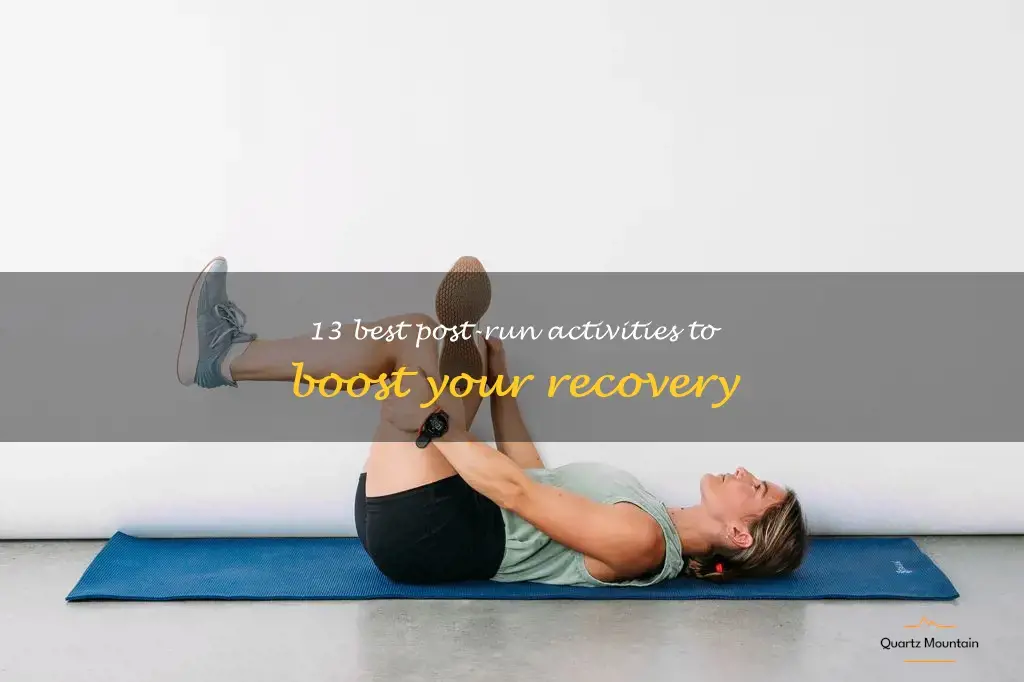
You've just finished a challenging and rewarding run. You've pushed your body to the limit, and you're feeling proud and accomplished. But now what? As important as the run itself is, what you do afterwards can make all the difference in how you feel in the coming days. To maximize your recovery and minimize soreness and fatigue, we've compiled a list of the 13 best post-run activities to help you feel your best and bounce back quickly. So, put down those running shoes and read on to discover how you can feel your best after your next run.
| # | Activity | Description |
|---|---|---|
| 1 | Stretching | Helps improve flexibility and reduces muscle soreness. |
| 2 | Hydration | Replenishes fluids lost during the run. |
| 3 | Protein intake | Aids in muscle recovery and rebuilding. |
| 4 | Cool down | Lowers the heart rate and gradually returns the body to rest. |
| 5 | Foam rolling | Massages and helps relieve muscle tension. |
| 6 | Refuel | Consuming a snack or meal that includes carbohydrates and protein. Helps in muscle glycogen replenishment. |
What You'll Learn

Stretching
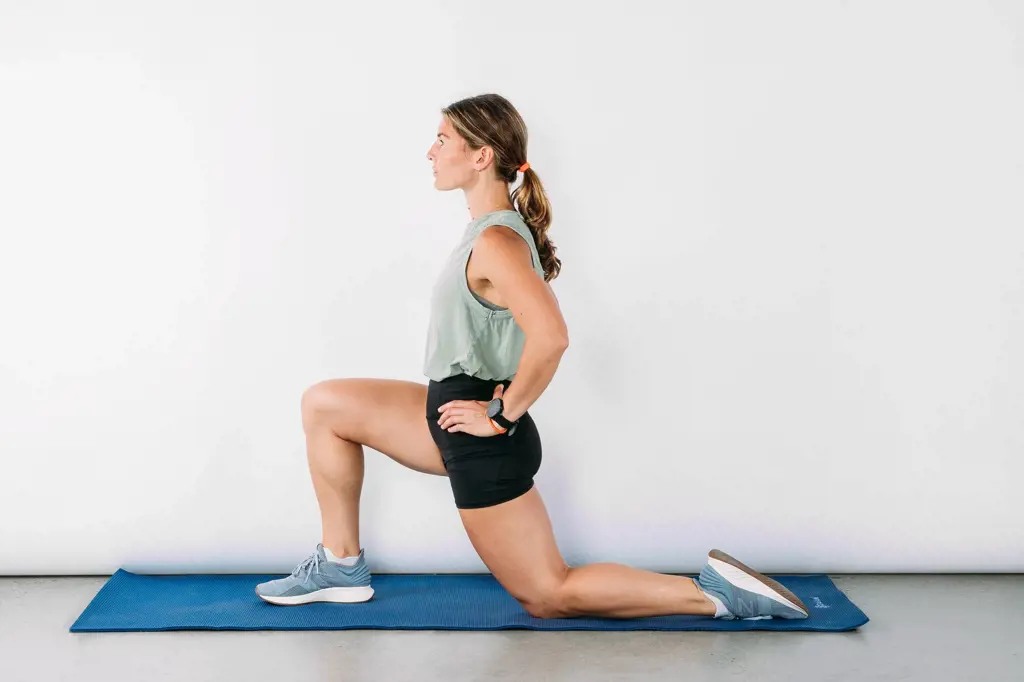
After completing a satisfying run, there are several things you can do to optimize your recovery and ensure that your body is in top condition for the next run. As important as running is, it's equally essential to perform some stretching exercises to keep your muscles flexible, enhance your range of motion, and minimize the risk of injury. In this article, we'll explore the best stretching exercises you can do after a run and discuss their benefits.
- Hamstring Stretch: This stretch targets the muscles in your upper legs and is an excellent way to loosen them up after a run. To perform the stretch, sit on the ground with your legs straightened in front of you. Keeping your back straight, extend forward and reach towards your toes until you feel a stretch in your hamstrings. Hold the position for 15-30 seconds, then slowly return to the starting position and repeat.
- Quad Stretch: The quad muscles are located on the front of your thighs and work hard during a run, making it essential to stretch them after a workout. Stand straight, and bend your right knee backward, reaching your foot with your left hand, hold for 15-30 seconds, then repeat on the other leg.
- Hip Flexor Stretch: The hip flexors are the muscles that enable you to lift your knees towards your chest, and a tight hip flexor can contribute significantly to lower back pain and discomfort. To perform this stretch, kneel on your right knee and ensure that your left knee is bent at a 90-degree angle in front of you. Place both your hands on your left thigh, and slowly shift your body weight forward until you feel a gentle stretch in your hip flexors. Hold for 15-30 seconds, then repeat with the other leg.
- Calf Stretch: Tight calves are a common issue for runners, and stretching your calf muscles can help improve flexibility and prevent injury. Stand facing a wall with your feet shoulder-width apart, and the balls of your feet against the wall. Gently push your heels towards the floor until you feel a stretch in your calves. Hold for 15-30 seconds, then repeat.
- IT Band Stretch: The IT (Iliotibial) Band is an essential muscle that runs from the hip to the knee and can become tight after a run. To stretch your IT band, cross your left foot in front of your right foot, while keeping your legs straight. Reach your right hand over your head, lean towards the left until you feel a stretch along the side of your right leg. Hold this position for 15-30 seconds, then repeat with the right leg.
12 Fun Things to Do in Fairfield, CT
You may want to see also

Foam rolling
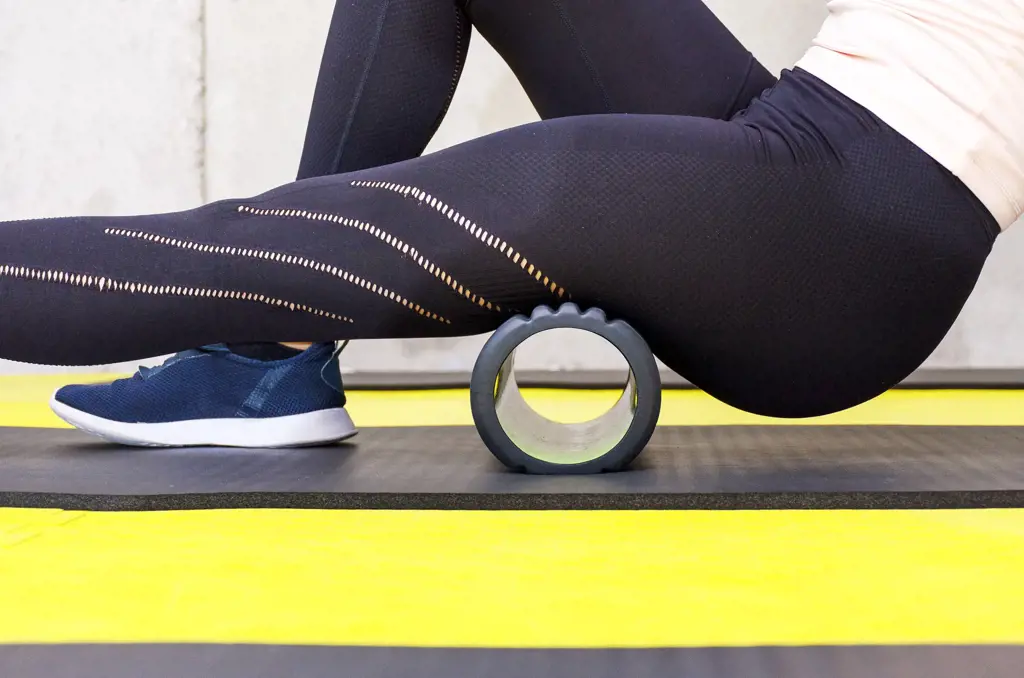
After completing a run, many people feel energized and invigorated but could also experience soreness or stiffness in their muscles. One of the best things to do post-run is foam rolling. Foam rolling is a technique used for self-myofascial release, which helps decrease muscle tightness and soreness. It is a simple and effective way to aid in the recovery process and ensure that muscles are ready to go for the next run. Here are some benefits and tips for foam rolling after a run.
Benefits of Foam Rolling:
- Reduces Muscle Soreness - Foam rolling can aid in reducing muscle soreness by breaking down knots or adhesions that may form during running.
- Improves Flexibility - Foam rolling can increase flexibility and range of motion by releasing tension and stiffness in muscles.
- Enhances Blood Circulation - Rolling on a foam roller helps improve blood flow and promote the delivery of oxygen and nutrients to the muscles which aid in recovery.
Tips for Foam Rolling:
- Start Slow - If you are new to foam rolling, start with a lighter pressure, and gradually increase the pressure according to your comfort level.
- Focus on the Tight Areas - Identify the muscle groups that are tight, sore, or tender from running, and concentrate on those areas when foam rolling.
- Roll Slowly - Roll the foam roller slowly along each muscle group, spending time on each tight or sore spot, and taking deep breaths throughout the process.
- Stay Hydrated - It is essential to remain hydrated after any physical activity, including foam rolling. Drink plenty of water to help eliminate toxins from the body and speed up the recovery process.
- Make it a Habit - Consistency is key when it comes to foam rolling. Make it a regular part of your routine, especially on days when you run or participate in other strenuous activities.
13 Fun Things to Do in Fort Myers Beach at Night
You may want to see also

Yoga
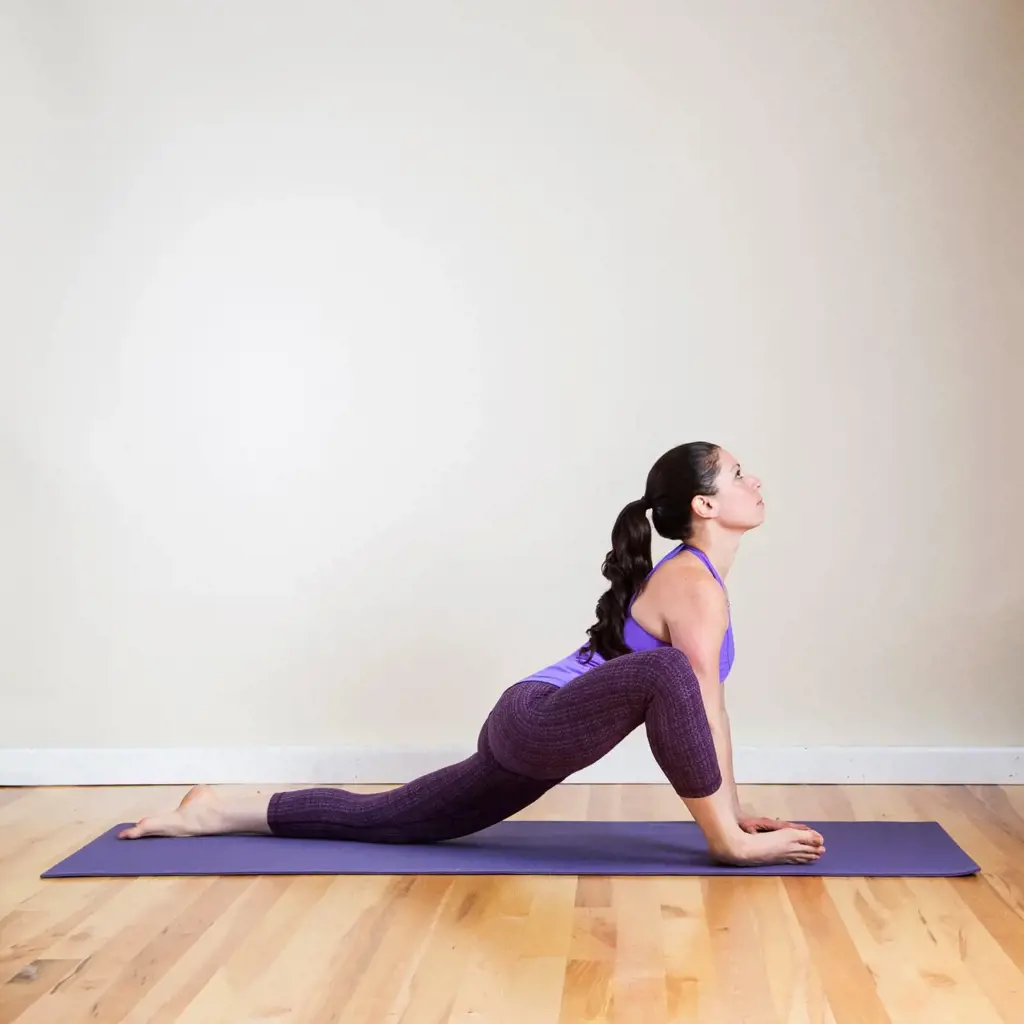
Running is an exhilarating exercise, but it can also take a toll on your body. After a good run, it's important to take the time to cool down and do some stretches to help your muscles recover. One great way to get the most out of your cool-down is to incorporate some yoga poses into your post-run routine.
- Downward-facing dog: This pose stretches out your hamstrings, calves, and back muscles. It also helps to lengthen your spine and improve your posture. Start on your hands and knees, then lift your hips up and back to come into downward dog. Keep your hands shoulder-width apart and your feet hip-width apart. Hold for 5-10 breaths.
- Pigeon pose: Pigeon pose is a deep hip opener that can help relieve tension in your hips and glutes. Begin in a high plank position, then bring your right knee forward towards your right hand. Lower your right hip to the ground and straighten your left leg behind you. If you're feeling comfortable, fold forward over your right leg. Hold for 5-10 breaths, then switch sides.
- Cobra pose: Cobra pose is a gentle backbend that helps stretch out your abdominal muscles and relieve tension in your lower back. Begin lying face-down on the ground with your hands under your shoulders. Press into your hands to lift your chest up off the ground, keeping your elbows close to your body. Hold for 5-10 breaths, then release.
- Warrior II: Warrior II is a standing pose that strengthens your legs and stretches out your hips. Begin in a high lunge position with your right foot forward. Pivot your left foot to face the side of your mat and bend your right knee to come into Warrior II. Reach your arms out to shoulder height and gaze over your right hand. Hold for 5-10 breaths, then switch sides.
- Child's pose: Child's pose is a gentle resting pose that can help you relax and unwind after a run. Begin on your hands and knees, then sit back on your heels and stretch your arms forward. Rest your forehead on the ground and take a few deep breaths. Hold for as long as you'd like.
Incorporating yoga into your post-run routine can help you get the most out of your workout. These poses will help you stretch out your muscles, improve your flexibility, and calm your mind. Give them a try and see how you feel!
10 Fun Activities to Try in Mosaic District
You may want to see also

Ice bath
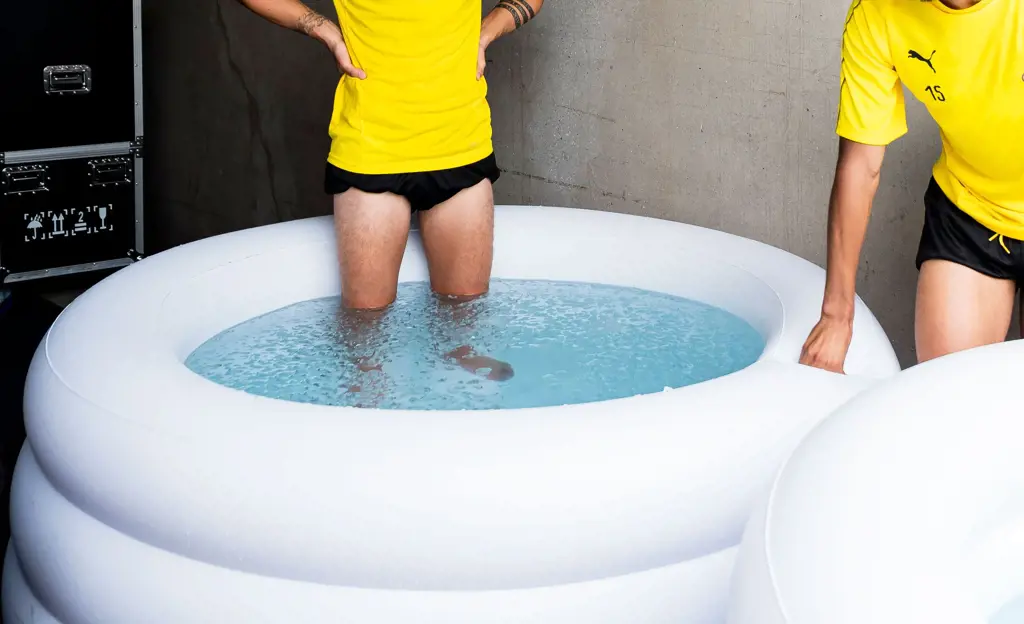
As runners, we all know the feeling of post-run soreness and fatigue. While stretching and cooling down exercises are great ways to alleviate the discomfort, ice baths are among the best things you can do to speed up muscle recovery.
An ice bath, also known as cold-water immersion, involves sitting in a bathtub or pool filled with cold, icy water for a few minutes after a run. Here are some reasons why an ice bath should be a part of your post-run routine:
Reduces inflammation: Running causes micro-tears in your muscles, which leads to inflammation. This inflammation is what causes soreness and slows down muscle recovery. Immersing yourself in cold water causes your blood vessels to constrict, thereby reducing inflammation.
Boosts circulation: Cold water immersion also helps improve blood flow, which reduces muscle swelling. This improved circulation also helps to remove metabolic waste from your muscles, helping to speed up recovery.
Reduces soreness: Perhaps the most significant benefit of an ice bath is that it reduces muscle soreness. This happens because the exposure to cold water numbs the nerves in the muscle, creating an analgesic effect. This means you’ll feel less sore and will be ready to go for your next run earlier.
Getting started with ice baths is easy. Once you've finished your run, fill a bathtub/ bucket/ pool with cold water and ice cubes. You'll want to aim for a temperature of around 12-15 degrees Celsius. You don't want the water too cold as the pain might be unbearable. Submerge your body in the water for 5-10 minutes before getting out and warming up with a towel or warm clothes.
If you're not a fan of cold water immersion, there are also other ways to reduce soreness and inflammation. These include light yoga stretches, foam rolling, using a massage gun, and drinking lots of water.
In conclusion, ice baths are one of the best things you can do for your muscles after a run. By reducing inflammation, boosting circulation, and reducing soreness, ice baths help to speed up muscle recovery and get you back on track to your next training day. So, next time you finish a run, consider taking a dip in icy water to make the most of your recovery time.
14 Exciting Things to Do in Las Vegas for Thrill Seekers
You may want to see also

Epsom salt bath
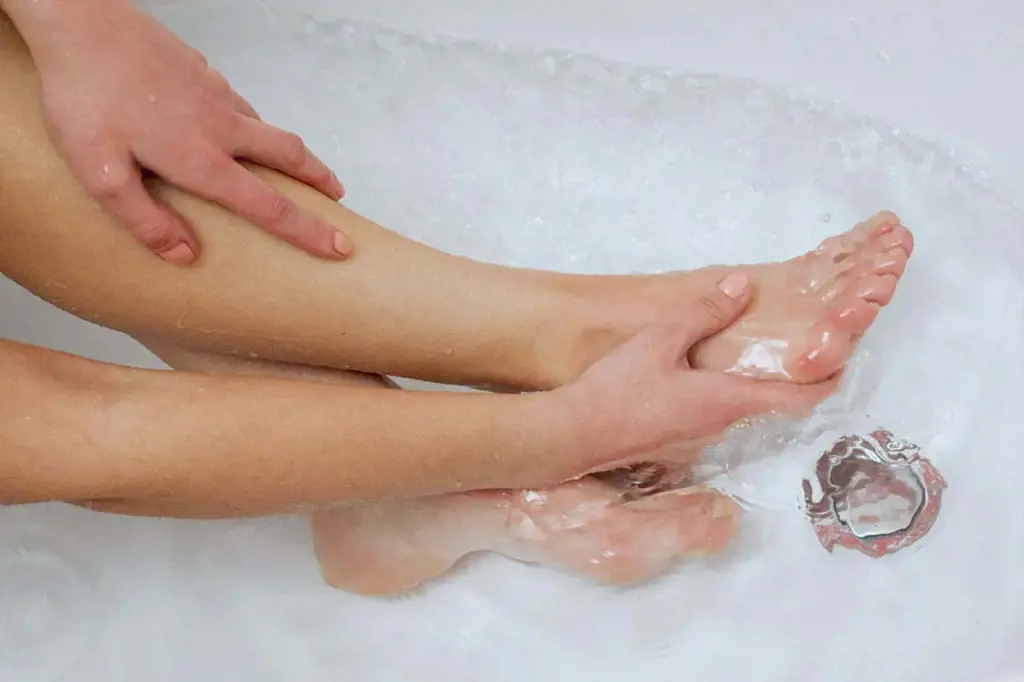
After completing a challenging run, your body deserves the best care to help your muscles recover, and one great way to achieve this is by indulging in an Epsom salt bath. This magical mineral has been used for centuries for its therapeutic benefits, and it is especially ideal for treating sore and tired muscles.
Epsom salt is a naturally occurring compound composed of magnesium and sulfate minerals, and it has been praised for its ability to soothe the muscles and reduce inflammation. Here are some of the reasons why an Epsom salt bath should be on your list of the top things to do after a run.
Reduces inflammation - Running can cause tiny tears in the muscles which results in inflammation and soreness. Epsom salt received its reputation for reducing inflammation because of the magnesium that it contains. Magnesium helps ease the inflammation and pain related to soreness, speeding up your muscle recovery time.
Relieves stress - Long runs can be physically and mentally demanding, and it is important to take time to relax afterward. Soaking in a warm Epsom salt bath is an excellent way to unwind and de-stress. The magnesium found in Epsom salt acts as a natural muscle relaxer, promoting restful sleep and reducing stress levels.
Improves circulation - Epsom salt increases the circulation of blood and oxygen around your body and can help counteract the negative effects of sitting or standing for extended periods, such as achy legs. This boost in circulation enhances muscle recovery and reduces swelling and inflammation associated with running.
Easy to use - Using Epsom salt couldn't be simpler, and to take advantage of its benefits, you only need to add a few cups of it into a bathtub filled with warm water. Stir it well and soak in the tub for at least 20 minutes. You can also add some essential oils for added relaxation.
In conclusion, an Epsom salt bath is a perfect way to pamper your body after a run. This inexpensive and simple method provides numerous benefits for your muscles, skin, and overall wellbeing. By making this relaxing and invigorating ritual a part of your routine after your runs, you can ensure your body is ready for its next challenge.
13 Free Activities to Enjoy in Hocking Hills
You may want to see also

Massage
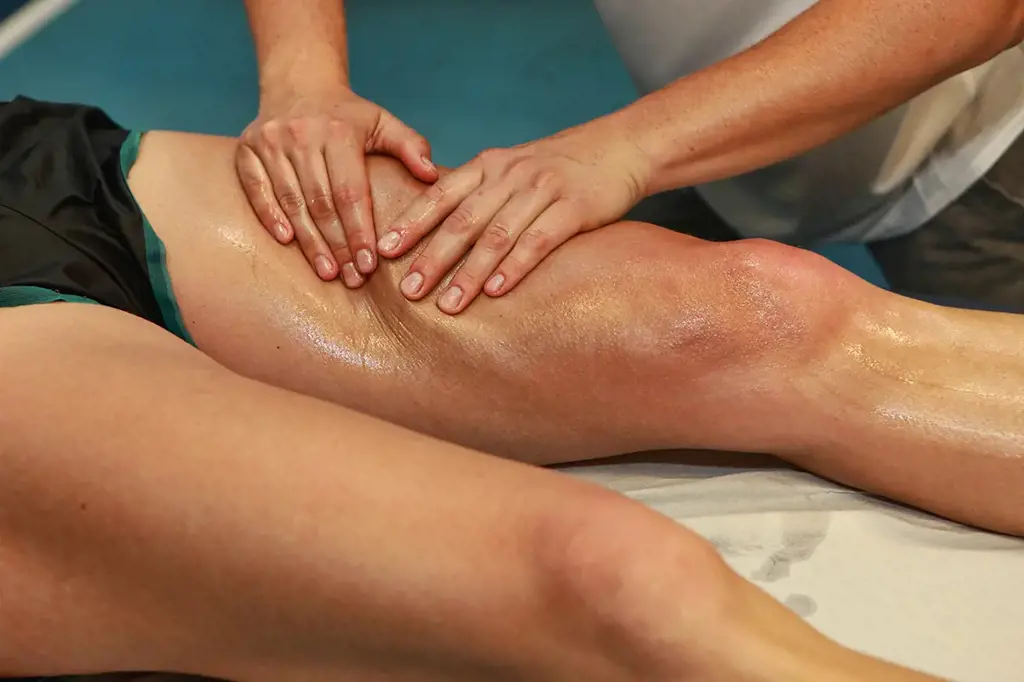
After a vigorous and intense run, it’s important to honor and take care of your body by doing the best things that can help you recover and optimize your performance. One of the most effective ways to recover after a run is to get a massage. Not only does it feel amazing and soothing, but it can also relieve any soreness, pain, and tension in your muscles.
When it comes to massage after a run, there are several types you can choose from. A Swedish massage is a popular option that involves long, flowing strokes combined with gentle kneading and stretching motions that are perfect for relaxing your muscles. Another great option is a deep tissue massage, which is designed to target deep muscles and connective tissue to help release any knots or adhesions that may have formed in your muscles. If you prefer a more targeted or focused massage, you can opt for a sports massage, which is customized to manage the specific needs and demands of athletes. A sports massage can help prevent post-exercise soreness, promote healing, and reduce the risk of injury.
The ideal time to get a massage after a run is usually within the first 24-48 hours, while your muscles are still warm and tender. This can help speed up your body's own natural healing process and prevent any further damage from happening. You can also choose the timing of your massage depending on your schedule and how you feel. Some people prefer to get a massage immediately after their run or later in the evening, while others might wait until the next day when their muscles feel more sore and stiff.
Where can I get a massage?
There are many places where you can get a massage after a run, such as spas, hotels, or clinics. Additionally, there are also many massage therapists who offer mobile services and can come to your home or place of work. Alternatively, you can also consider using a self-massage tool such as a foam roller or massage ball at home, which can be just as effective in reducing muscle soreness and improving circulation.
Overall, massage is an excellent and effective post-run recovery tool that can help you feel better and optimize your performance. Whether you seek professional help or do it yourself, incorporating massage into your post-run routine can provide numerous benefits and help you maintain your endurance and fitness levels. So why not give it a try? Your body will thank you for it.
12 Fun Activities to Experience in Washington County
You may want to see also

Walking
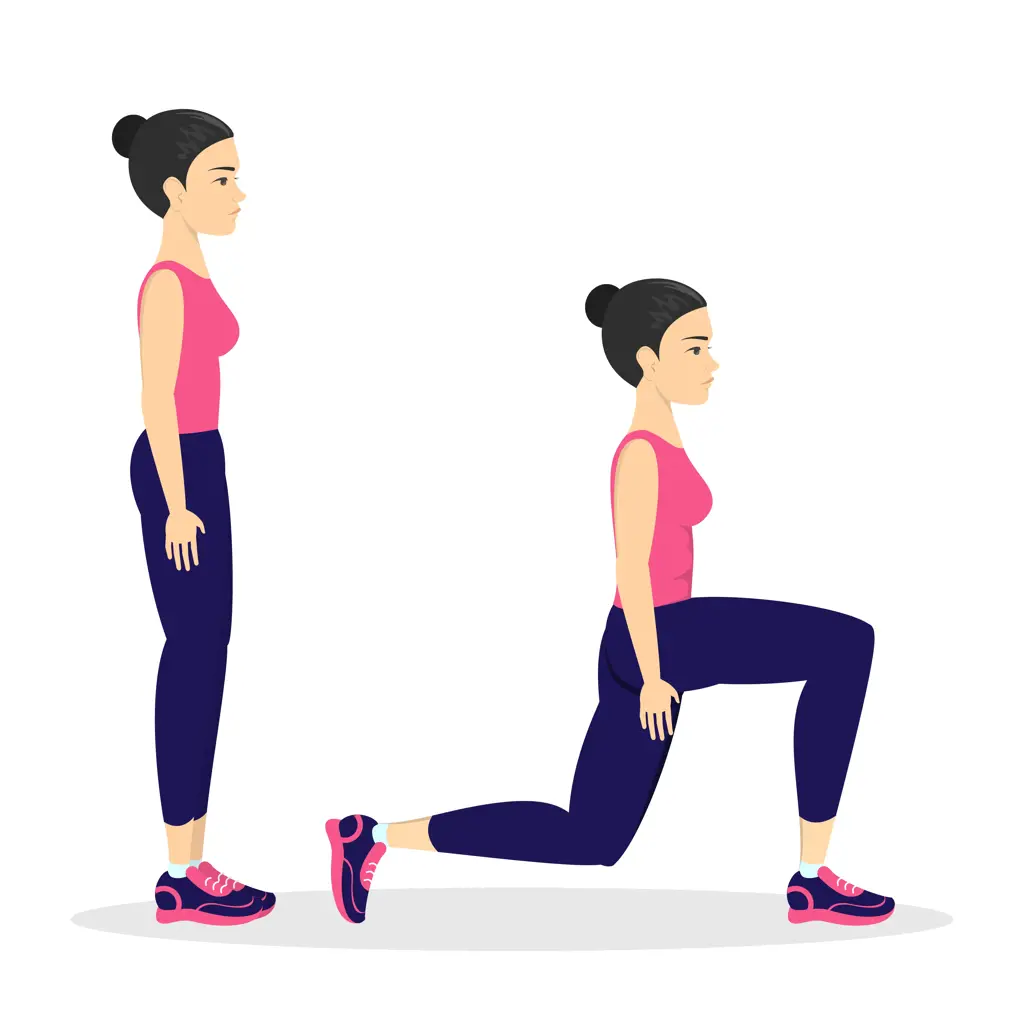
After completing a run, it is normal to feel exhausted and depleted. However, it is essential to engage in activities that can help you recover and prevent soreness in your muscles. One of the best things to do after a run is to take a walk. Walking helps you cool down and gradually bring your heart rate back to a resting state. Here are some benefits of walking after a run:
- Promotes blood flow: While running, blood is pumped to your legs and other muscles in your body. Taking a walk after a run helps to distribute blood evenly throughout your body, which improves blood circulation. Walking also helps to prevent blood from pooling in your legs, which could cause cramps.
- Helps to release tension: Running can cause tension buildup in your muscles, particularly in your calves, hips, and thighs. Walking after a run can help to release muscle tension and prevent soreness. When you walk, you engage your muscles differently from when you run, which can help to relieve tension.
- Aids in recovery: After a run, your body needs time to recover. Walking after a run helps to speed up the recovery process by stimulating blood flow, promoting muscle relaxation and reducing inflammation. Walking also helps to flush out metabolic waste from your muscles, which could cause soreness.
- Low-impact exercise: Running can be tough on your joints, especially if you have a history of joint problems. Walking is a low-impact exercise that puts less strain on your joints. By taking a walk after a run, you will be engaging in exercise that is less taxing on your joints, which will help to prevent injuries.
In conclusion, taking a walk after a run is an excellent way to cool down, prevent muscle soreness and promote blood flow. It is a low-impact exercise that can help to speed up your recovery process and prevent injuries. Remember to take it easy and enjoy the scenery while you walk. Happy running!
12 Fun Things To Do In Wake Forest, NC
You may want to see also

Swimming
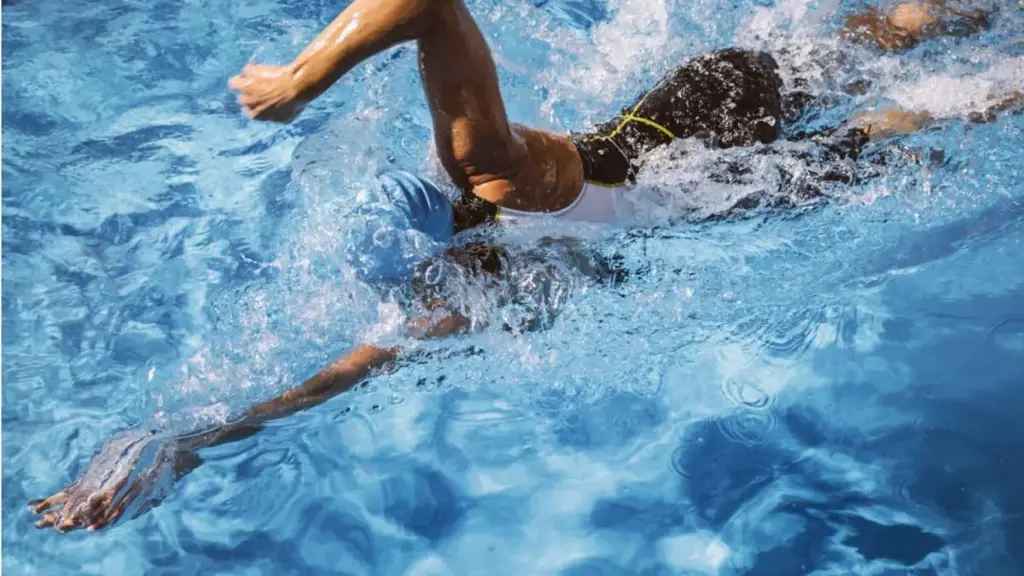
Running is a great way to get in shape and stay healthy, but after a run, you may be wondering what the best things are to do to help your body recover and prepare for your next workout. One excellent option is to head to the pool and go for a swim.
Another great benefit of swimming is that it can help you burn a lot of calories. Depending on how vigorously you swim, you can burn anywhere from 400 to 700 calories per hour, which is more than what you would burn during a lot of other workouts. This makes it a great option if you are trying to lose weight or maintain a healthy weight.
Finally, swimming is a fun and refreshing activity that can leave you feeling rejuvenated and energized. The cool water can be especially soothing if you are feeling hot or sweaty after your run. Plus, it can be a great way to socialize and connect with other people who love to swim.
Overall, if you are looking for the best things to do after a run, swimming is an excellent option that can help you recover, improve your fitness, and leave you feeling refreshed and invigorated. So why not grab your swimsuit and head to the pool after your next run? Your body will thank you for it.
12 Fun Things to Do in Minocqua, Wisconsin
You may want to see also

Cycling
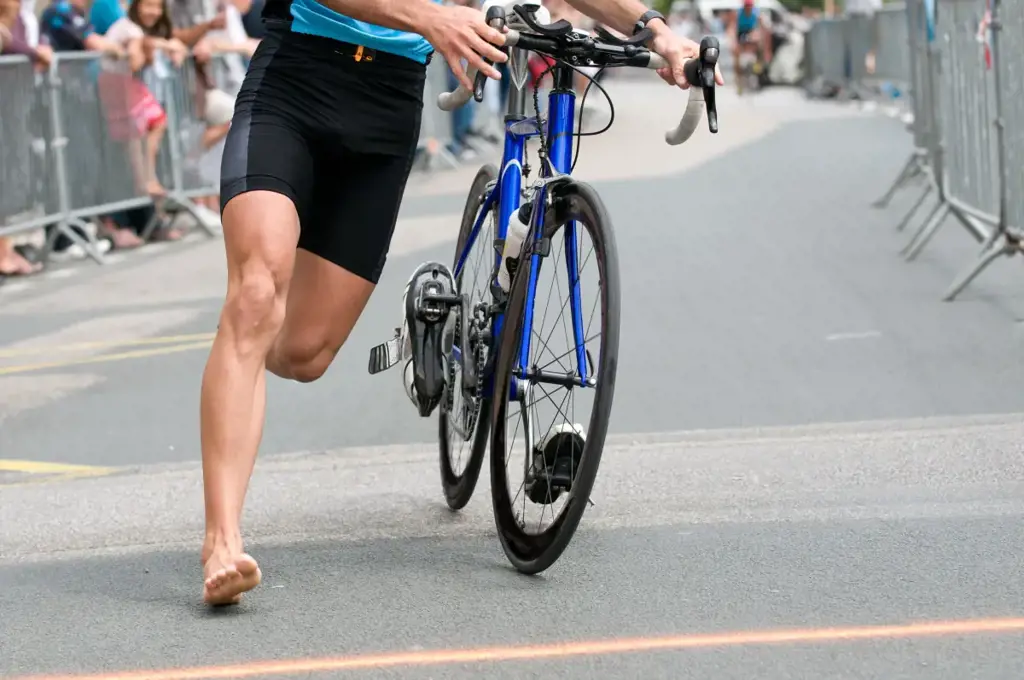
If you have just finished an intensive run, congratulations! It's not easy to push your body to its limit, but the benefits are undeniable. However, your workout is not complete just yet. The cool-down and recovery phase is just as vital as the actual running. One of the best things you can do after a run is to cycle.
Low-Impact Exercise
Running is a high-impact activity that puts a lot of stress on your joints and lower body. Cycling, on the other hand, is a low-impact exercise that is gentle on your knees and joints. By cycling after a run, you help your body recover without putting additional stress on your joints.
- Active Recovery
- Variety in Cardiovascular Workout
- Cool-Down
As mentioned earlier, cycling after a run can help you cool down. By slowly pedaling on a stationary bike or outdoors, you're decreasing your heart rate and breathing rate, which brings your body back to its resting state.
Mentally Beneficial
In conclusion, cycling after a run can be an excellent way to cool down and facilitate the recovery process. It offers low-impact exercise, active recovery, variety in cardiovascular workouts, a cool-down phase, and mental benefits. At the end of the day, it is essential to listen to your body, and if cycling does not suit you, there are plenty of other recovery activities to try out such as stretching, foam rolling, or yoga.
12 Romantic Ventures to Embark on in Deep Creek MD
You may want to see also

Sipping on a recovery shake
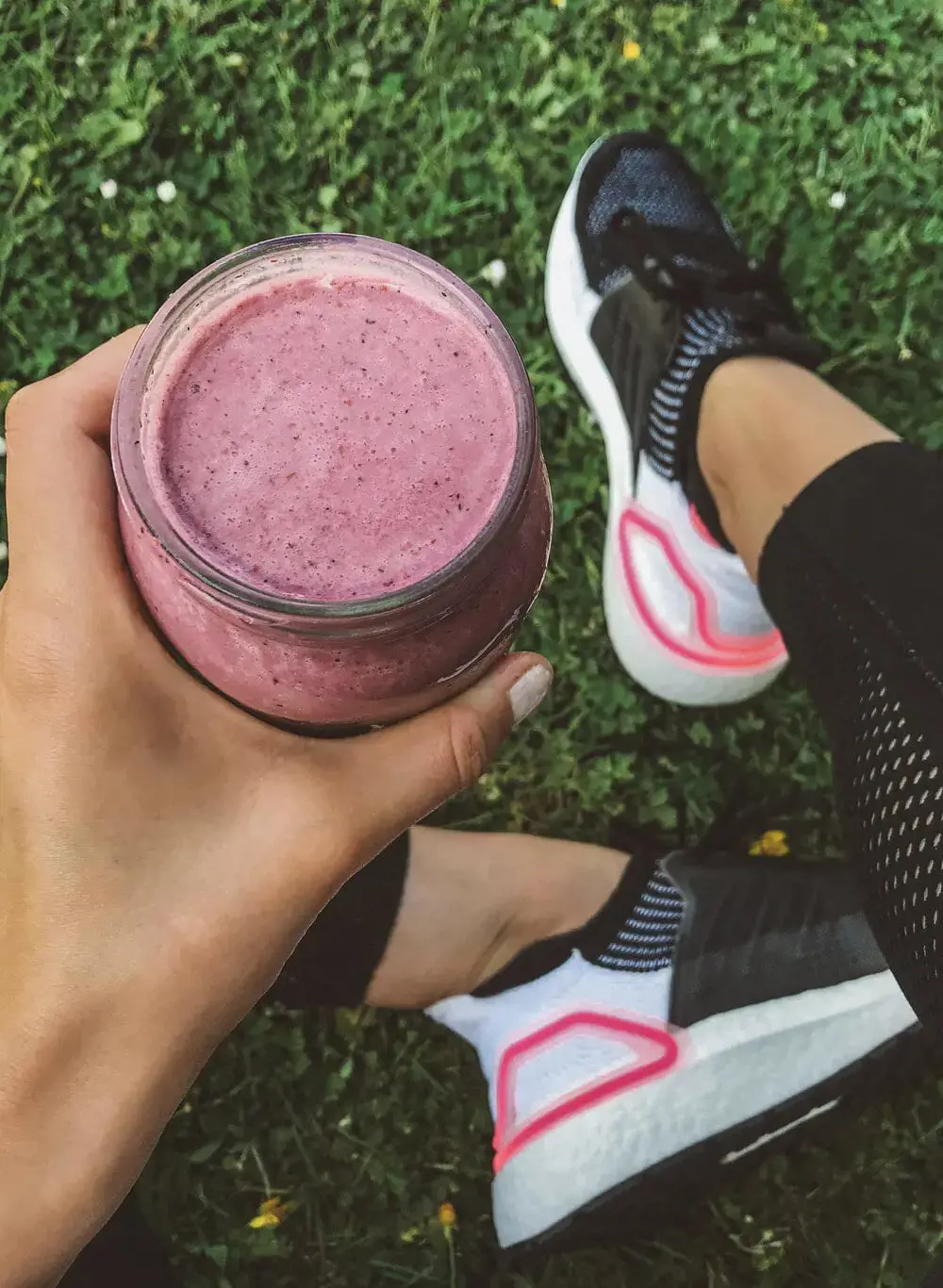
Running is an excellent way to improve your health, increase your endurance, and boost your mood. A good run can leave you feeling energized and invigorated. However, as important as it is to get out there and run, it is equally crucial to replenish your body with the right nutrients. One way to aid your recovery after a run is by sipping on a recovery shake.
A recovery shake contains a mix of protein, carbohydrates, and fluids that help your body recover from the stress of exercise. Here are some reasons why sipping on a recovery shake after your run is one of the best things you can do for your body.
Replenishes Nutrients
After your run, your muscles need the right nutrients to repair and rebuild. A recovery shake that contains a mix of carbohydrates and protein can help replenish glycogen stores in the body and provide muscle fibers with the amino acids needed to rebuild and recover. For optimal recovery, aim for a shake that contains a ratio of carbohydrates to protein of 3:1 or 4:1.
Hydrates Your Body
Running causes you to sweat, which can lead to dehydration. Hydration is essential for optimal body function, and a recovery shake can help hydrate your body after a run. You can also add electrolytes to your shake, such as sodium and potassium, which are lost through sweat.
Reduces Muscle Soreness
Muscle soreness is common after a run and can make it challenging to stick to your training routine. A recovery shake that contains protein, carbohydrates, and anti-inflammatory nutrients can help reduce muscle soreness and aid recovery.
Promotes Muscle Growth
Protein is essential for muscle growth, and a recovery shake that contains protein can assist in building muscle mass and strength. After a run, your muscles are in a state of repair and rebuilding, and protein intake can help speed up this process.
Running is an excellent way to stay fit and healthy, but proper nutrition is just as important as exercise. Sipping on a recovery shake after a run can help replenish your body with the nutrients it needs to recover and reduce muscle soreness. So, if you haven't tried a recovery shake before, give it a go, and your body will thank you. Remember, optimal recovery involves a mix of good nutrition, hydration, rest, and sleep. Make sure to prioritize all of these factors to enhance your fitness and health.
13 Fun Things to Do in Plymouth, Wisconsin
You may want to see also

Low-impact strength training
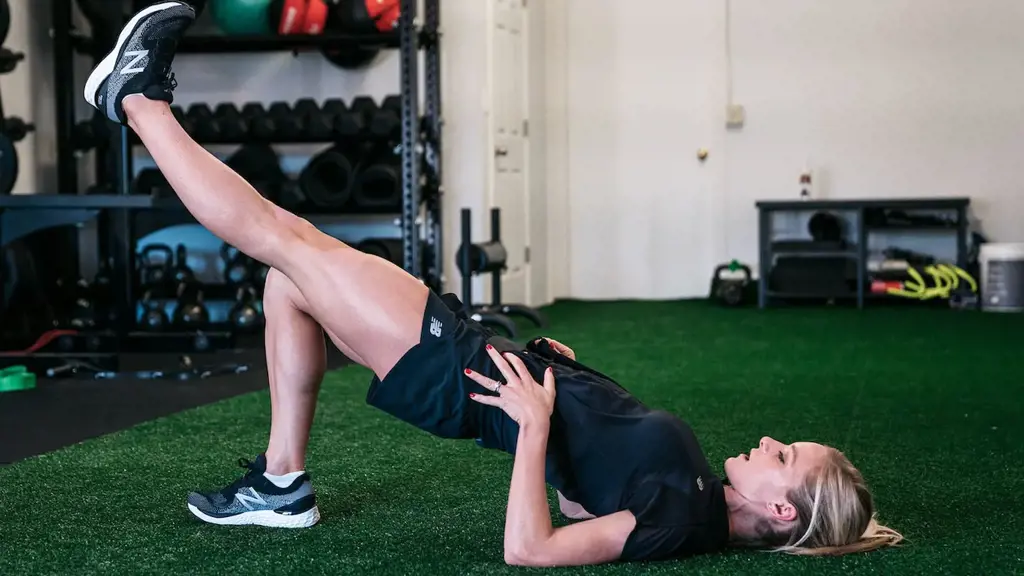
Running is an excellent way to get your blood pumping, your heart racing, and your body moving. It's a great form of exercise that offers many health benefits, such as improved cardiovascular health, increased endurance, and weight loss. But what should you do after you go for a run? One of the best things you can do is to incorporate low-impact strength training exercises into your routine.
Plank
The plank is a great exercise to focus on your core strength and stability. By doing a plank, you strengthen your core muscles, which helps to improve your posture and reduce back pain. To perform a plank, start in a push-up position with your hands slightly wider than your shoulders. Lower yourself to your forearms and hold your body in a straight line for at least 30 seconds.
Lunges
Lunges are excellent for strengthening your glutes, hamstrings, and quadriceps. They also help improve your balance and coordination, which is essential for runners. Start by standing with your feet shoulder-width apart and take a large step forward with your left foot, keeping your right foot behind you. Lower your body until your left thigh is parallel to the ground and your left knee is directly over your ankle. Return to the starting position and repeat with the other leg.
Squats
Squats are a great exercise for building leg strength, especially the quadriceps, hamstrings, and glutes. It also helps improve overall balance and coordination, which is crucial for runners. To perform a squat, start by standing with your feet shoulder-width apart. Lower your body as if you're sitting down on a chair and keep your knees and feet aligned. Straighten your legs to return to the starting position.
Bird Dog
Bird Dog is an excellent exercise to improve your core strength and balance. It targets your lower back, hips, and glutes. Begin by getting down on all fours with your hands and knees shoulder-width apart. Extend your left leg behind you while extending your right arm in front of you. Hold for a few seconds, return to the starting position, and repeat on the other side of your body.
In conclusion, low-impact strength training is essential for runners. It can help improve your running performance, build strength, and reduce the risk of injury. The exercises mentioned above are easy to implement, require no equipment, and can be done in a short amount of time. Incorporating these exercises into your post-run routine will help you achieve optimal results and keep your body in top shape.
12 Fun Things to Do in Bay City
You may want to see also

Meditation or deep breathing exercises

Running is an excellent way to stay fit and healthy both physically and mentally. After a fulfilling run, it is essential to take the time to allow your body to cool down and relax. While stretching is crucial, adding a meditation or deep breathing exercise to your routine can provide even more benefits and help you reap the full rewards of your workout.
Meditation and deep breathing exercises are excellent ways to clear your mind, reduce stress, and calm your nervous system. After a run, your body is in a heightened state, and your muscles are tensed up. A few minutes of focused breathing and meditation can relax your muscles and calm your mind, promoting a faster recovery.
To get started with meditation, find a quiet space that is free from distractions. Sit down on the floor or a mat and find a comfortable position that allows you to focus. Close your eyes and take a few deep breaths in through your nose and out through your mouth. As you breathe, focus your mind on your breath and try to quiet any thoughts that enter your mind.
While meditating, it is normal for your mind to wander. If your thoughts start to drift, gently bring your focus back to your breath, allowing your mind to quiet once again. Start with a few minutes and gradually increase the duration as you become more comfortable with the practice.
Deep breathing exercises are another excellent way to unwind after a run. This exercise involves taking long, deep breaths and holding them for a few seconds before releasing them slowly. Deep breathing can help to lower your heart rate and blood pressure, reducing the stress on your cardiovascular system.
To practice deep breathing, find a comfortable position either lying down or sitting up. Inhale slowly through your nose, filling up your lungs to capacity. Hold your breath for a few seconds, and then exhale slowly through your mouth, releasing every bit of air from your lungs. Repeat the cycle several times, taking as much time as you need to feel the benefits.
In conclusion, a significant part of any workout routine is the post-workout recovery phase. Adding meditation or deep breathing exercises to your routine can provide numerous benefits, including reduced stress, relaxation, and an improved recovery process. Taking a few minutes to focus on your breath can make a big difference in how you feel and perform after a run. So, the next time you finish a fulfilling run, take some time to breathe deep and enjoy the benefits of mindfulness and relaxation.
12 Fun Things to Do in Monroeville, PA
You may want to see also

Enjoying a healthy meal

After a long run, your body needs the right kind of nutrition to recover and replenish the muscles and energy you used. That's why enjoying a healthy meal is one of the best things you can do after a run. Here are some tips on how to optimize your post-run meal to help your body recoup and improve your overall performance.
Firstly, make sure you're hydrating well. Water is the best drink to quench your thirst after a run, as it helps to replenish all the fluids you lost. You can also consider incorporating foods with high water content to your meal, such as fruits and vegetables.
Secondly, focus on getting enough protein. Protein is essential for repairing and building muscles, which can get damaged during intense runs. You can have a protein shake or choose foods like eggs, chicken, fish, or beans to get that much-needed protein kick.
Thirdly, include some carbohydrates in your meal. Carbs are the body's primary source of energy, and you need to replenish your glycogen stores that were depleted during the workout. Opt for whole-grain versions and avoid processed carbs for optimal digestion and nutrient absorption.
Fourthly, try to eat some healthy fats. Fats provide long-lasting energy as they take longer to digest. Include foods like nuts, avocado, or oily fish to provide your body with the right kind of fats to facilitate recovery.
Finally, don't forget to eat some fruits and vegetables as they are packed with vitamins, minerals, and antioxidants that help fight inflammation and support your immune system.
In conclusion, enjoying a healthy meal after a good run can significantly improve your performance and overall well-being. Ensure you are hydrating well, getting enough protein, incorporating carbs, healthy fats, and fruits, and vegetables for optimal recovery. With these tips, you'll be able to reap the full benefits of your workout and be on your way to a healthier and more active lifestyle.
14 Fun Things to Do in Spring, TX
You may want to see also
Frequently asked questions
- It's best to wait until you cool down before stretching, as stretching warm muscles can lead to injury. Instead, take a few minutes to walk or jog at a slower pace to allow your heart rate and breathing to return to normal before starting your stretching routine.
- A combination of carbohydrates and protein is best for post-run refueling. Consider options such as a banana with peanut butter, Greek yogurt with fruit, or a smoothie with protein powder.
- Your body temperature will naturally start to cool down shortly after you finish running, but it's best to wait at least 10-15 minutes before taking a shower to allow your muscles to relax and reduce the risk of cramping.
- Yes, using foam rollers or massage balls can help ease muscle tension and soreness after a run. Focus on rolling out your legs and glutes for 5-10 minutes to aid in post-run recovery.
- Yes, you should hydrate after a run even if you don't feel thirsty. Your body loses fluids through sweating during exercise, and drinking water or a sports drink post-run can help replenish lost fluids and prevent dehydration.








3 Comments
Caiden Richard
Sofia Jennings
AuthorLenny Swanson